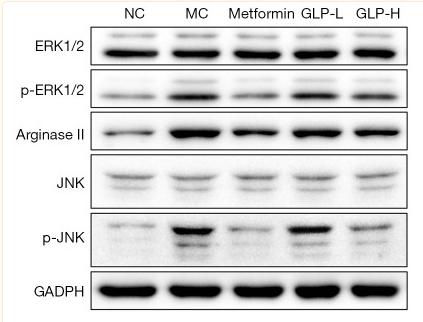ARG2 Antibody - #DF3792
| Product: | ARG2 Antibody |
| Catalog: | DF3792 |
| Description: | Rabbit polyclonal antibody to ARG2 |
| Application: | WB IF/ICC |
| Cited expt.: | WB |
| Reactivity: | Human |
| Mol.Wt.: | 38 KD; 39kD(Calculated). |
| Uniprot: | P78540 |
| RRID: | AB_2836149 |
Related Downloads
Protocols
Product Info
*The optimal dilutions should be determined by the end user. For optimal experimental results, antibody reuse is not recommended.
*Tips:
WB: For western blot detection of denatured protein samples. IHC: For immunohistochemical detection of paraffin sections (IHC-p) or frozen sections (IHC-f) of tissue samples. IF/ICC: For immunofluorescence detection of cell samples. ELISA(peptide): For ELISA detection of antigenic peptide.
Cite Format: Affinity Biosciences Cat# DF3792, RRID:AB_2836149.
Fold/Unfold
ARG2; ARGI2_HUMAN; Arginase II mitochondrial; Arginase type II; Arginase-2; arginase-2, mitochondrial; Kidney arginase; Kidney type arginase; Kidney-type arginase; L arginine amidinohydrolase; L arginine ureahydrolase; mitochondrial; Non hepatic arginase; Non-hepatic arginase; Nonhepatic arginase; Type II arginase;
Immunogens
A synthesized peptide derived from human ARG2, corresponding to a region within C-terminal amino acids.
Expressed most strongly in kidney and prostate, much less strongly in the brain, skeletal muscle, placenta, lung, mammary gland, macrophage, uterus, testis and gut, but apparently not in the liver, heart and pancreas. Expressed in activated T cells (PubMed:27745970).
- P78540 ARGI2_HUMAN:
- Protein BLAST With
- NCBI/
- ExPASy/
- Uniprot
MSLRGSLSRLLQTRVHSILKKSVHSVAVIGAPFSQGQKRKGVEHGPAAIREAGLMKRLSSLGCHLKDFGDLSFTPVPKDDLYNNLIVNPRSVGLANQELAEVVSRAVSDGYSCVTLGGDHSLAIGTISGHARHCPDLCVVWVDAHADINTPLTTSSGNLHGQPVSFLLRELQDKVPQLPGFSWIKPCISSASIVYIGLRDVDPPEHFILKNYDIQYFSMRDIDRLGIQKVMERTFDLLIGKRQRPIHLSFDIDAFDPTLAPATGTPVVGGLTYREGMYIAEEIHNTGLLSALDLVEVNPQLATSEEEAKTTANLAVDVIASSFGQTREGGHIVYDQLPTPSSPDESENQARVRI
Research Backgrounds
May play a role in the regulation of extra-urea cycle arginine metabolism and also in down-regulation of nitric oxide synthesis. Extrahepatic arginase functions to regulate L-arginine bioavailability to nitric oxid synthase (NOS). Arginine metabolism is a critical regulator of innate and adaptive immune responses. Seems to be involved in negative regulation of the survival capacity of activated CD4(+) and CD8(+) T cells. May suppress inflammation-related signaling in asthmatic airway epithelium. May contribute to the immune evasion of H.pylori by restricting M1 macrophage activation and polyamine metabolism (By similarity). In fetal dendritic cells may play a role in promoting immune suppression and T cell TNF-alpha production during gestation. Regulates RPS6KB1 signaling, which promotes endothelial cell senescence and inflammation and implicates NOS3/eNOS dysfunction. Can inhibit endothelial autophagy independently of its enzymatic activity implicating mTORC2 signaling. Involved in vascular smooth muscle cell senescence and apoptosis independently of its enzymatic activity. Since NOS is found in the penile corpus cavernosum smooth muscle, the clitoral corpus cavernosum and the vagina, arginase-2 plays a role in both male and female sexual arousal.
Mitochondrion.
Expressed most strongly in kidney and prostate, much less strongly in the brain, skeletal muscle, placenta, lung, mammary gland, macrophage, uterus, testis and gut, but apparently not in the liver, heart and pancreas. Expressed in activated T cells.
Belongs to the arginase family.
Research Fields
· Human Diseases > Infectious diseases: Parasitic > Amoebiasis.
· Metabolism > Amino acid metabolism > Arginine biosynthesis.
· Metabolism > Amino acid metabolism > Arginine and proline metabolism.
· Metabolism > Global and overview maps > Metabolic pathways.
· Metabolism > Global and overview maps > Biosynthesis of amino acids.
References
Application: WB Species: Rat Sample: cavernosum tissue
Restrictive clause
Affinity Biosciences tests all products strictly. Citations are provided as a resource for additional applications that have not been validated by Affinity Biosciences. Please choose the appropriate format for each application and consult Materials and Methods sections for additional details about the use of any product in these publications.
For Research Use Only.
Not for use in diagnostic or therapeutic procedures. Not for resale. Not for distribution without written consent. Affinity Biosciences will not be held responsible for patent infringement or other violations that may occur with the use of our products. Affinity Biosciences, Affinity Biosciences Logo and all other trademarks are the property of Affinity Biosciences LTD.

